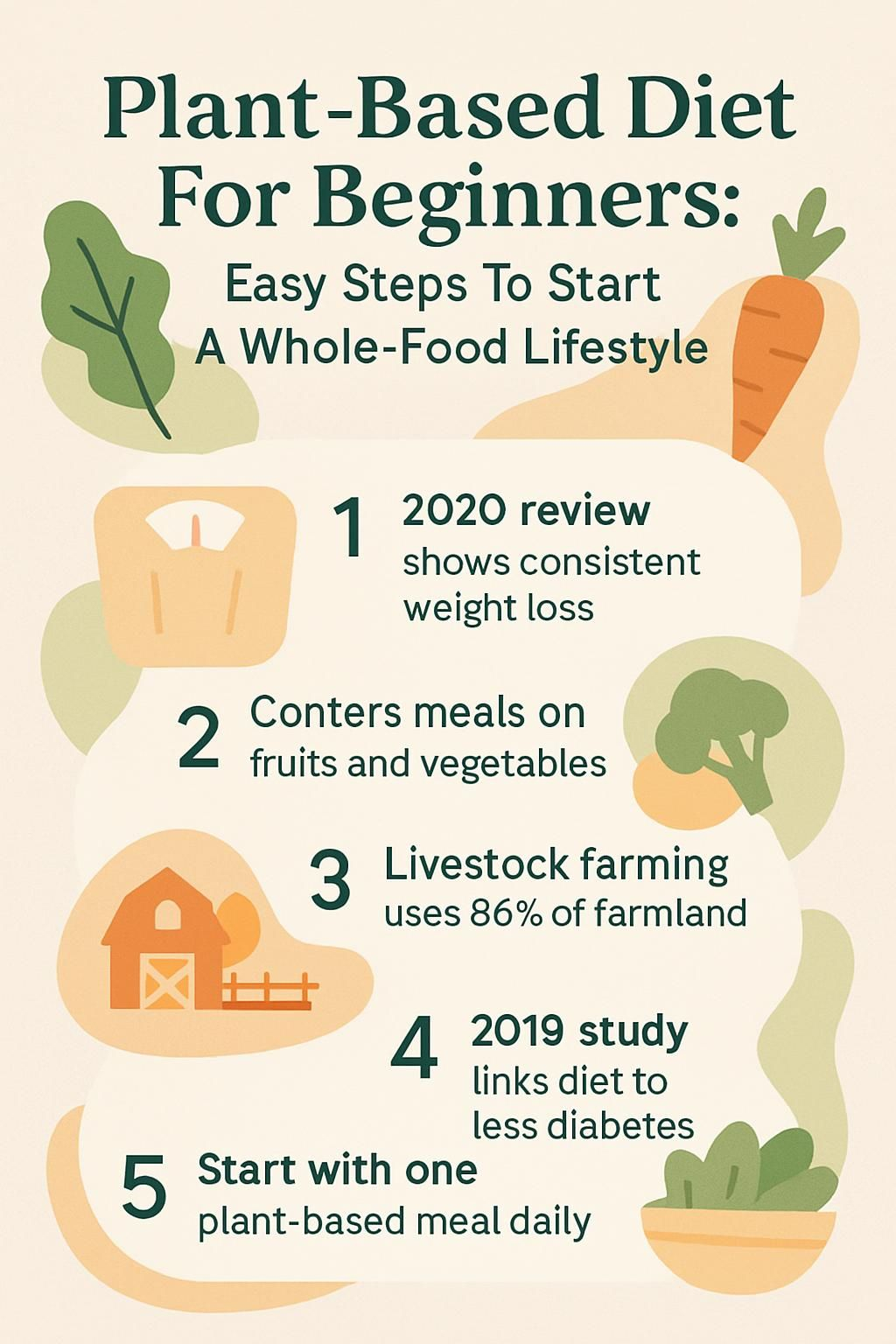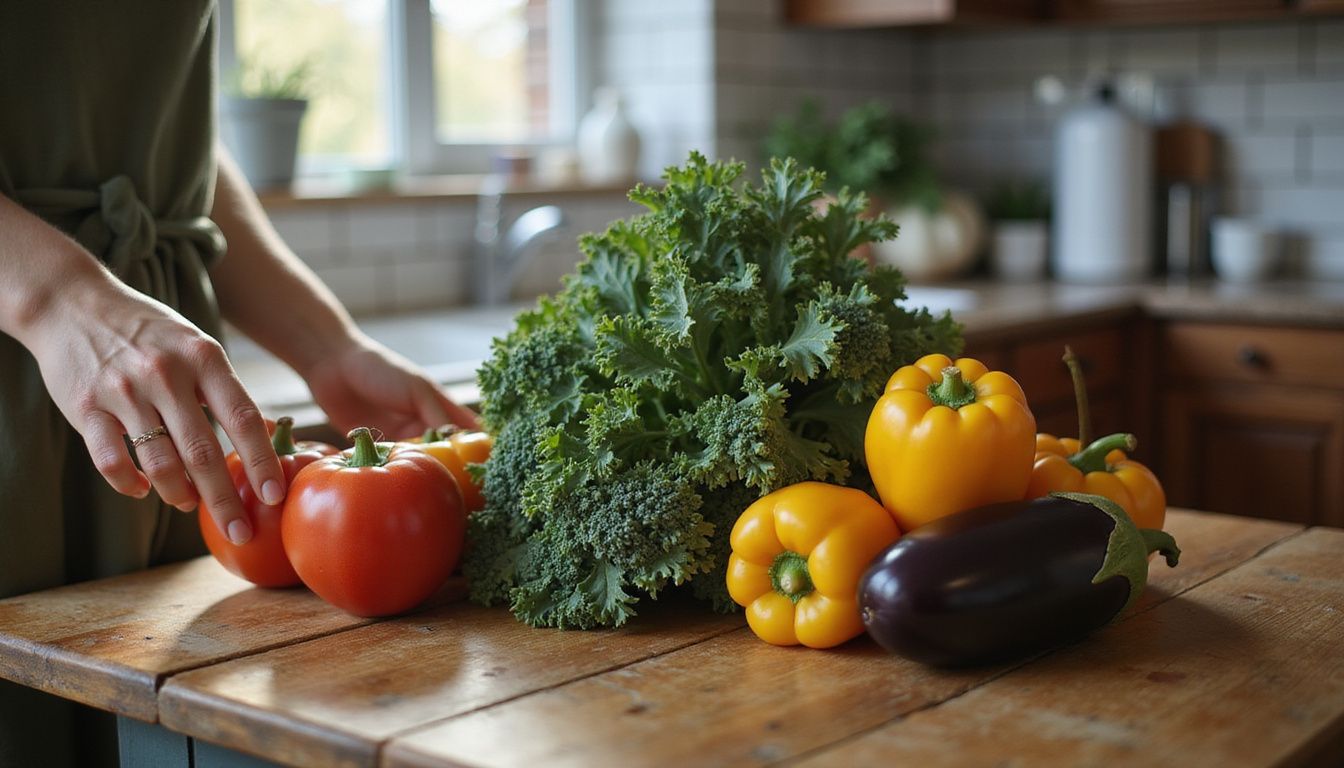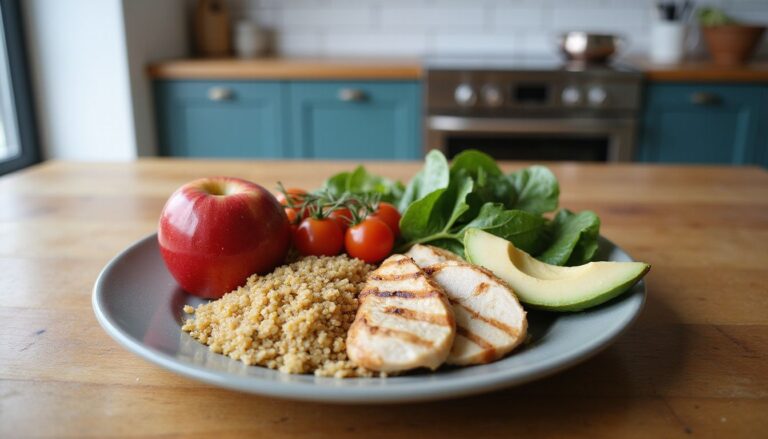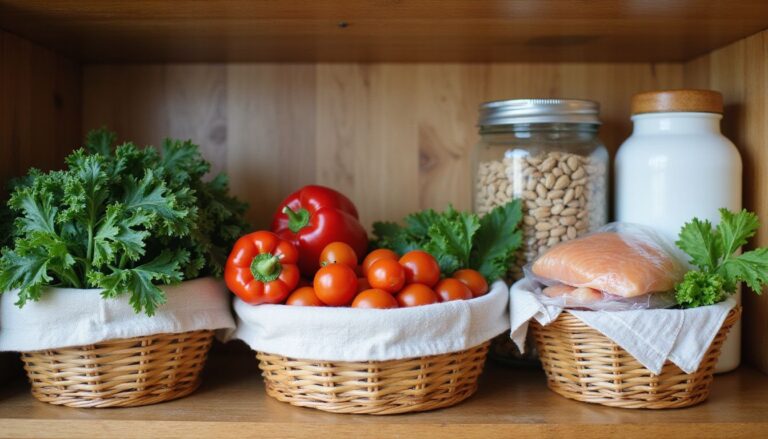Plant-Based Diet For Beginners: Easy Steps To Start A Whole-Food Lifestyle
Our Nutrition Assistant AI Suite will transform your body. You will lose fat, get toned, and build muscle. Gain confidence and optimal health.
You want better health, steady energy, and a simpler way to eat. A plant-based diet for beginners can deliver all three. Research links plant-focused eating with lower weight, healthier hearts, and fewer chronic diseases.
This guide gives you clear steps, smart tips, and easy examples so you can start with confidence. Small changes add up. You will see how whole foods on your plate lead to real results over time.
Key Takeaways
- Plant-based eating is tied to lower cholesterol, blood pressure, and chronic disease risk. A 2020 review of 19 trials reported consistent weight loss.
- A whole-food, plant-based pattern highlights fruits, vegetables, legumes, nuts, seeds, and whole grains while limiting animal products and ultra-processed foods.
- Shifting your plate to plants reduces environmental strain. Livestock uses 83% of farmland yet provides only 18% of global calories, based on a 2018 analysis.
- Higher fiber intake improves digestion and blood sugar control. Studies show fewer cases of type 2 diabetes among plant-forward eaters.
- Dietitians suggest starting with one plant-based meal daily and planning ahead to build lasting habits.

What is a Plant-Based Diet?

A plant-based diet centers meals on foods that grow from the ground, such as fruits, vegetables, legumes, nuts, seeds, and whole grains. The goal is to eat mostly plants for better nutrition, steady energy, and long-term health.
What defines a plant-based diet and its focus on whole foods?
Plant-based eating favors whole or minimally processed foods. Your mainstays include fresh or frozen produce, tubers like potatoes and sweet potatoes, intact whole grains such as oats and brown rice, and legumes like beans, lentils, and peas.
Many people reduce or avoid animal products, including meat, fish, eggs, and dairy. Others keep small amounts, yet still build meals around plants. The focus is nutrient density and fiber, not strict rules.
Think spinach salads with chickpeas, oatmeal with berries, or a stir-fry with tofu and vegetables. These meals supply vitamins, minerals, and fiber that support digestion and heart health. Studies summarized by organizations like Forks Over Knives and leading journals report consistent benefits for plant-forward eaters.
A simple swap can help. Switching white toast for rolled oats with blueberries and walnuts keeps you full longer due to the extra fiber and healthy fats.
How is a plant-based diet different from a vegan diet?
Plant-based describes an eating pattern centered on whole plants. Some followers include small amounts of fish or dairy. Vegan describes a lifestyle that avoids all animal-derived items, including food and goods like leather and wool.
Vegan choices can still be highly processed, for example cookies or chips. A whole-food, plant-based approach encourages limiting processed items along with animal products to improve health outcomes.
People often choose whole-food plant-based eating for health reasons, such as heart support or weight management. Veganism is often driven by ethical concerns as well as dietary choice. Since vitamin B12 is scarce in natural plant foods, health agencies advise B12-fortified foods or supplements, especially for adults over 50.
Understanding your goals helps you plan meals that fit your life. Next, explore why more people are choosing a plant-based path.
Why Choose a Plant-Based Diet?
Eating more plants can lift your health and lower your environmental footprint. The science is clear and growing, and many beginners notice benefits within weeks.
What health benefits can I expect from a plant-based diet?
Expect help with weight control, blood pressure, and cholesterol. A 2020 review of 19 intervention studies found steady weight loss for people who adopted a plant-forward pattern.
Whole plants are lower in saturated fat and rich in fiber. This combination supports healthy arteries and better blood sugar control. Research, including a 2018 paper in BMJ Open Diabetes Research & Care, links plant-based eating with fewer cases of type 2 diabetes.
Many report more energy, less inflammation, and better digestion. Some also note improvements in kidney markers and fewer joint symptoms.
“Whole-food, plant-based nutrition helps prevent heart disease and supports better well-being.”
Fiber from fruits, vegetables, legumes, grains, nuts, and seeds feeds your gut microbiome. A healthy microbiome supports immunity and may affect mood and weight balance.
How does a plant-based diet reduce your environmental impact?
Choosing plants conserves land and water. Livestock takes up the vast majority of farmland yet provides a smaller share of calories. Eating beans, grains, and produce cuts waste in the food chain since you eat crops directly.
Staples like beans and brown rice also have lower greenhouse gas emissions than red meat and many dairy products. These swaps help shrink your climate footprint without giving up flavor or satisfaction.
What are the ethical reasons to adopt a plant-based lifestyle?
Many people pick plant-based eating to avoid supporting practices that harm animals. Industrial animal farming often involves stress and poor living conditions for animals.
History shows these values are not new. Thinkers in ancient Greece promoted plant-rich eating long ago. Today, choosing items like grains, legumes, soy foods, nuts, seeds, and produce lowers demand for animal-based goods, including non-food items like leather.
This shift aligns daily choices with compassion and supports kinder systems across the food supply.
The Five Food Groups in a Plant-Based Diet
Balance is the backbone. Build your plate with a mix of produce, grains, legumes, nuts, seeds, and plant proteins at most meals.
Fruits and vegetables
Make fruits and vegetables half your plate. Aim for color variety, sometimes called eating the rainbow. Try apples, berries, citrus, peppers, leafy greens, and broccoli to cover vitamins A, C, K, and more.
Whole fruit beats juice for fiber. Frozen options work well when produce spoils before you eat it. Sliced veggies with hummus can outlast chips for fullness and give steady afternoon energy.
Whole grains
Whole grains provide complex carbohydrates, which digest slowly and fuel your day. Pick oats, brown rice, quinoa, barley, and whole wheat bread or pasta.
They also supply iron and zinc. Choose intact grains when possible, since refining removes fiber and nutrients. Start with oatmeal or quinoa for breakfast, then use brown rice or barley in lunch bowls and dinners.
Whole-grain flours are helpful for variety. Use them in moderation because they are more calorie dense than intact grains.
Legumes and beans
Beans, lentils, chickpeas, and peas are nutrient-dense and budget-friendly. They offer plant protein, fiber, folate, iron, and potassium. Canned versions save time, but pick low-sodium labels when you can.
Use beans in salads, soups, stews, tacos, and burgers. Research links pulses like lentils with better cholesterol and a lower risk of heart disease. Start simple, for example a lentil soup or black bean chili, and build from there.
Nuts and seeds
Nuts and seeds deliver healthy fats, fiber, and plant protein. Almonds, walnuts, cashews, sunflower seeds, chia seeds, and flaxseed are great choices.
Flaxseed and chia supply omega-3 fatty acids, which support heart and brain health. Enjoy nut butters on toast or fruit. Use a small handful daily to add crunch and nutrition without overdoing calories.
Tahini, made from sesame seeds, provides healthy fat and calcium. Roasted chickpeas or sunflower seed butter can make snacks more filling between meals.
Plant-based protein sources like tofu and tempeh
Tofu and tempeh come from soybeans and provide complete protein, meaning all nine essential amino acids. Tofu ranges from soft to extra firm, so it works in scrambles, stir-fries, and smoothies.
Tempeh is fermented, with a firm texture and nutty taste. It grills well, absorbs marinades, and makes a hearty taco or bowl topping. A typical 3-ounce serving offers around 8 grams of protein for tofu and 15 grams for tempeh.
Swap crumbled tempeh for ground meat or toss grilled tofu onto salads. Use moderate portions if you are tracking calories for weight goals.
Benefits of a Whole-Food, Plant-Based Diet
More whole plants can be a turning point for health. Think of it as upgrading your daily fuel.
How does this diet help with weight management?
Whole plants are rich in fiber and water, which lowers calorie density. You feel full on fewer calories. Potatoes, beans, and vegetables help you eat satisfying portions without overeating.
A 2020 review of 19 studies showed reliable weight loss, even when calories were not counted. Fiber from greens, legumes, and whole grains supports appetite control and digestive health.
Real people see progress. Some report large weight losses on whole-food plant-based plans by focusing on simple, low-cost meals like oatmeal, quinoa bowls, and bean chili.
What cardiovascular benefits come from a plant-based diet?
Studies suggest a lower risk of heart disease when you eat more plants. A 2021 review of 99 studies found better heart outcomes on plant-forward patterns compared with diets high in meat and dairy.
Less saturated fat and cholesterol helps reduce blood pressure and LDL cholesterol. Some people even see markers of artery function improve, along with reduced inflammation.
Fruits, vegetables, legumes, nuts, and whole grains work as a team to support cleaner arteries over time.
How does it reduce the risk of chronic diseases?
A diet built on whole plants supports blood sugar control and healthier cholesterol. Evidence from 2018 in BMJ Open Diabetes Research & Care linked plant-centered eating with better diabetes management.
Limiting saturated fat lowers the chance of clogged arteries and hypertension. Choosing greens, beans, and nuts in place of processed foods or red meat can also reduce chronic inflammation, which is tied to many diseases.
Some individuals report reversing diabetes markers after moving to a whole-food, plant-based routine. These stories show what is possible with consistent habits and support.
In what ways does it support sustainable living?
Whole-plant diets use fewer resources per meal. You save land and water and reduce emissions simply by choosing beans, grains, and vegetables more often.
Eating plants directly skips the losses that occur when crops are fed to animals first. This is one reason many environmental experts call plant-based eating a practical choice for climate health.
How to Start a Plant-Based Diet
Start small, then build. The best plan is the one you can keep.
How can I start with one plant-based meal a day?
Pick one meal, and make it plant-based every day. Breakfast is often easiest. Try oatmeal with fruit and peanut butter, or a smoothie with greens and fortified soy milk.
For lunch, build a grain bowl with quinoa, beans, greens, and avocado. At dinner, cook a lentil chili or a tofu stir-fry loaded with vegetables. Invite a friend to join you for extra support.
Gradual shifts stick better over time. Planning ahead boosts success and helps you include all five food groups: fruits, vegetables, whole grains, legumes, and nuts or seeds. A registered dietitian can help tailor ideas to your health needs, especially if you are pregnant or breastfeeding.
Check nearby restaurants for plant-based choices when cooking is not an option. Keep it simple, repeat favorite meals, and build your rotation.
Next up, see why focusing on whole foods multiplies the benefits.
Sources:
1) Academy of Nutrition and Dietetics, 2022: Gradual approaches support lasting habits.
2) Harvard T.H. Chan School of Public Health: Diverse plant groups improve diet quality.
3) American Heart Association: Dietitians can guide nutrient balance in vegetarian plans.
Why focus on whole and minimally processed foods?
Whole foods pack more vitamins, minerals, and fiber than ultra-processed items. They are filling, which helps with weight goals, and they offer steady energy without big spikes and crashes.
Leafy vegetables, oats, quinoa, and lentils deliver nutrients your body uses to protect the heart and brain. Several large studies link whole-food patterns with lower risks of conditions such as breast cancer and cognitive decline.
Processed plant foods often include extra salt, sugar, and additives that do not support long-term health. Many heart-healthy patterns, including the Mediterranean diet, limit refined grains and added sugars for this reason.
Cooking more at home, even simple meals, can improve digestion and energy within weeks. Buying fewer packaged snacks also cuts waste and encourages family meals built on whole ingredients.
How to experiment with plant-based recipes?
Start with recipes that match your taste and skill. Cookbooks like The Mayo Clinic Diet or Cook Smart Eat Well offer step-by-step guides that are easy to follow.
Try black bean and corn salsa, cracked wheat chili, or pesto-stuffed mushrooms. For a flexitarian twist, build a taco bowl with beans, brown rice, and extra vegetables. Online meal planners can supply weekly menus and shopping lists.
Group classes or short video lessons can boost confidence with tofu, tempeh, nuts, and seeds. After taking a free workshop, I tried olive tapenade at home. It became a crowd favorite at gatherings.
Rotate new recipes with a few reliable standards to prevent boredom and keep costs predictable.
Foods to Include in Your Diet
Build your plate with colorful plants, quality carbs, lean plant proteins, and healthy fats. These choices support energy, mood, and long-term health.
Which fresh fruits and vegetables are best?
Choose a mix for full coverage of nutrients. Apples, bananas, berries, and citrus bring vitamin C and antioxidants. Leafy greens like spinach and kale provide calcium, iron, and vitamins A and K.
Include broccoli and other cruciferous vegetables. Artichokes and asparagus add fiber and a bit of plant protein. Seasonal produce often tastes better and costs less. Frozen fruit is a smart backup to prevent waste.
Whole fruit beats juice because of the fiber. Keep washed produce at eye level in the fridge so you reach for it first.
What whole grains should I eat like quinoa and oats?
Rotate quinoa, brown rice, barley, oats, whole wheat, wild rice, and buckwheat. Quinoa is a complete protein and cooks quickly. Brown rice is a low-cost staple that works with many flavors.
Top oatmeal with fruit and seeds for breakfast. Use whole-grain breads or tortillas for sandwiches and wraps. Switching between several grains keeps meals interesting and helps cover nutrients like iron and zinc.
A simple mix of oats, seeds, and berries can keep you full for hours compared with refined cereal.
What are good plant-based protein options?
Great options include beans, lentils, chickpeas, tofu, tempeh, and seitan. A half cup of cooked beans gives about 7 to 9 grams of protein. Three ounces of tofu or tempeh supplies about 8 to 15 grams.
Whole grains such as quinoa add another 8 grams per cooked cup. Vegetables like broccoli and spinach contribute extra grams that add up across the day. If you tolerate gluten, seitan is very high in protein.
Canned beans are convenient. Aim for around 50 grams daily or about 0.8 grams per kilogram of body weight, unless your clinician advises differently.
Which high-quality fats should I include?
Choose nuts, seeds, avocados, and small amounts of unrefined plant oils. Almonds, walnuts, sunflower seeds, chia, and flaxseed support heart and brain health. Omega-3 fatty acids from flaxseed and chia are especially helpful.
Tahini and nut butters supply healthy fats and minerals like magnesium and calcium. Add a small handful of nuts to oatmeal or salads. Swap butter for avocado on whole-grain toast for a creamy, satisfying upgrade.
Foods to Limit or Avoid
Some foods make it harder to reach your goals. Reducing them leaves more room for nutrient-dense plants.
Why limit animal-based proteins like meat and eggs?
Diets high in animal products tend to include more saturated fat and cholesterol, which raise the risk of heart disease and type 2 diabetes. Large studies connect plant-forward patterns with better heart health and improved weight control.
Plant proteins are more resource-efficient and often lower in calories. Swapping chicken or eggs for lentils or beans can improve cholesterol markers and save money on groceries.
Should I avoid dairy products on a plant-based diet?
Many whole-food, plant-based plans skip dairy and choose fortified plant milks, yogurts, and cheeses instead. Fortified options often include calcium and vitamin D.
For calcium without dairy, add tofu set with calcium, tahini, kale, or fortified plant milks. People with lactose intolerance may also feel better when they use non-dairy alternatives. Reducing dairy can lower saturated fat intake, which supports heart health.
What processed and refined foods should I avoid?
Limit ultra-processed foods high in salt, sugar, and refined oils. A snack labeled vegan is not automatically healthy if it has a long ingredient list.
Cut back on refined grains like white bread and regular pasta. Many packaged vegan meats and cheeses contain a lot of sodium. Read labels and choose products with simple ingredients and recognizable foods.
Focus on whole items from the grocery aisle such as oats, brown rice, and dried beans. This shift supports brain and heart health and reduces added sugars linked with inflammation.
Tips for Success
Practical routines make this lifestyle easier. Plan, prep, and get support so small wins become lasting habits.
How can meal planning and prep improve success?
Planning a week at a time saves money and cuts waste. A basic template includes whole grains, legumes, vegetables, fruits, and healthy fats across meals and snacks.
Batch cook beans and grains, roast trays of vegetables, and portion sauces for quick assembly. Freezing extras avoids last-minute takeout and helps you stay on track. Many families keep average meal costs near three dollars with this approach.
Meal prep also helps cover nutrients you might miss during busy weeks. It reduces guesswork and keeps your plan consistent.
Why is learning to read nutrition labels important?
Labels help you spot hidden animal ingredients and excess sodium, sugar, and saturated fat. They also show whether foods are fortified with vitamin B12, calcium, or iron.
Checking labels is vital if you manage conditions like heart disease or diabetes. It guides better choices, such as whole-grain bread over refined or lower-sodium beans over regular canned beans.
What are easy plant-based snacks to keep on hand?
Keep simple, whole-food snacks ready so choices are easy. Try these:
- Apple slices with almond butter
- Hummus with carrots, cucumbers, or bell peppers
- Roasted chickpeas or edamame
- Trail mix made with unsweetened dried fruit, seeds, and nuts
- Whole-grain crackers with nut or seed butter
- Fresh fruit or a small handful of mixed seeds
These options provide fiber, protein, and healthy fats. They keep you full and support heart health. In my pantry, roasted chickpeas in airtight jars help me skip sugary snacks after work.
How can joining a community help maintain motivation?
Support makes change easier. Join local groups, cooking classes, or online communities for recipe ideas, shopping tips, and encouragement.
Shared challenges like meatless Mondays build momentum. Quick check-ins with a group can keep you accountable during holidays or travel.
Sample 1-Day Plant-Based Meal Plan
Here is a simple day that balances flavor, nutrients, and convenience. Mix and match to fit your schedule.
What does a plant-based breakfast look like?
Try oatmeal topped with bananas, berries, and ground flaxseed. It delivers fiber and omega-3 fatty acids.
Prefer savory? Avocado on whole-grain toast with tomato and a sprinkle of seeds works well. A smoothie with greens, frozen fruit, and fortified soy milk adds calcium and vitamin B12.
How to prepare a plant-based lunch like a Buddha bowl?
Start with a base of brown rice or quinoa. Add leafy greens like spinach or kale. Roast sweet potatoes, broccoli, or carrots for texture and flavor.
Top with beans or lentils for protein. Add avocado or a handful of walnuts or sunflower seeds for healthy fats. Finish with a tahini-lemon dressing and a sprinkle of sesame seeds.
Home cooking lets you control sodium and oil. It also helps with weight goals and daily fiber intake.
What are healthy plant-based snack options?
Pair fresh fruit with nut butter, or choose raw vegetables with hummus. A small serving of nuts or seeds delivers lasting energy and key minerals.
Oatmeal with berries can be a snack, not just breakfast. Planning snacks in advance reduces impulse buys and supports stable blood sugar.
What is an example of a plant-based dinner?
Cook a One-Pot Tomato Basil Pasta using whole grain pasta, tomatoes, garlic, basil, and spinach. Serve it with a green salad dressed in olive oil and lemon juice.
This combination provides fiber, vitamins C and K, potassium, and iron, with little saturated fat. It is simple, fast, and family friendly.
Potential Challenges and How to Overcome Them
Any change can feel tricky at first. A plan, a list, and a few go-to meals can reduce stress and help you stay consistent.
How do I get enough protein on a plant-based diet?
Target about 50 grams per day for most adults, or 0.8 grams per kilogram of body weight unless your clinician recommends otherwise. Spread protein across meals.
Examples include lentil soup with whole-grain bread, tofu stir-fries, bean chili, and quinoa bowls with edamame. Nuts and seeds add extra grams across the day.
Tracking for a week can confirm you are on target. I logged meals for seven days and was surprised how quickly the grams added up with beans, soy foods, and grains.
How to address nutrient deficiencies like vitamin B12?
Vitamin B12 supports nerves and red blood cells. Since plants do not naturally provide it, use fortified foods or take a supplement as advised by your healthcare provider.
Fortified plant milks, breakfast cereals, and nutritional yeast are easy sources. Absorption declines with age, so adults over 50 often need a B12 supplement.
Plan for other key nutrients too, such as calcium, iron, zinc, iodine, and omega-3 fatty acids. A registered dietitian can tailor guidance to your needs or life stage.
What are tips for managing social situations and eating out?
Check menus online and pick restaurants with plant-friendly options. Share your preferences with friends or family before events. Bring a dish to potlucks, such as a bean salad or roasted vegetable tray.
Keep a small snack in your bag to bridge gaps between meals. Each positive choice builds confidence for the next time.
Common Myths About Plant-Based Diets
Myths can stall progress. Here are facts that help you move forward with less worry.
Is it true you can’t get enough protein?
You can meet protein needs with plants. Legumes, soy foods, whole grains, nuts, and seeds provide all the amino acids you need across the day.
One cup of cooked lentils has about 18 grams. Two slices of whole-grain bread add around 8 grams. Variety and consistency are what count.
Are plant-based diets really expensive?
They do not have to be. Staples like oats, potatoes, brown rice, and dried beans are among the most affordable foods in the store.
Many people report spending less after switching from processed snacks and meat to bulk grains and legumes. Careful planning and seasonal produce can stretch your budget further.
Do plant-based diets lack meal variety?
Options are vast. You can cook foods from many cultures using grains, beans, vegetables, herbs, and spices. Meal planners and starter cookbooks make it easy to test new dishes every week.
Exploring different cuisines keeps your menu fresh and makes the change more fun.
Tools and Resources for Beginners
Reliable tools save time and reduce guesswork. Use them to plan meals, track nutrients, and stay motivated.
What are the best plant-based cookbooks and meal planners?
“The Mayo Clinic Diet” and “Cook Smart, Eat Well” feature clear recipe steps and basic nutrition guidance. Both offer practical ideas for busy weeks.
Custom meal planners provide grocery lists, prep steps, and time-saving tips. Building a small library of trusted resources helps you learn faster and cook with confidence.
Where can I find online communities and support groups?
Large communities on Reddit, Facebook, and Forks Over Knives share recipes, shopping advice, and encouragement. Members post solutions for travel and eating out and discuss nutrients like vitamin B12.
Local meetups and plant-forward restaurants can add in-person support. Choose the format that fits your style and schedule.
What apps help with tracking nutrients and recipes?
Cronometer and MyFitnessPal help you log foods, scan barcodes, and check vitamin and mineral intake. Tracking for a few weeks can reveal gaps and guide smart tweaks.
Apps like Yazio and Whisk store recipes and build weekly menus from your phone. Seeing nutrition facts before you cook keeps meals aligned with your goals.
Real-Life Success Stories
Real people show what is possible with steady steps and simple meals.
Who has successfully transitioned to plant-based living?
One woman adopted a plant-based diet and lost 80 pounds. She also noticed fewer asthma issues and needed less medication.
A couple shifted to whole-food, plant-based meals together. He lost 150 pounds, and she lost 45 pounds with strong support at home.
Another person focused on plant foods and dropped total cholesterol by 130 points, cutting LDL in half. Someone else reversed diabetes markers within months after switching to a whole-food plan.
Planning and community support help these changes stick. Sharing progress in online groups can make new recipes feel easier and more fun.
Conclusion
Starting a plant-based diet for beginners does not have to be complicated. Begin with one meal a day, build simple routines, and focus on whole foods like fruits, vegetables, legumes, nuts, seeds, and whole grains.
Research shows plant-based eating can lower cholesterol and blood pressure and reduce the risk of heart disease and type 2 diabetes. It also supports a lighter environmental footprint with each meal.
Try a new recipe each week and keep a few easy standbys for busy nights. With planning and practice, this way of eating becomes affordable, satisfying, and sustainable.
This information is educational, not medical advice. If you have a health condition, are pregnant or breastfeeding, or take medications, talk with a healthcare professional or registered dietitian for personalized guidance.
FAQs
1. What is a plant-based diet and how does it differ from veganism?
A plant-based diet centers on whole foods like fruits, vegetables, grains, legumes, nuts, and seeds. Unlike veganism which excludes all animal products for ethical reasons, a plant-based approach focuses on health by prioritizing unprocessed foods while some people may still include small amounts of animal-derived items.
2. How can beginners transition to a whole-food lifestyle using easy steps?
Start with gradual changes such as adding more leafy greens or beans to meals each week. Replace processed snacks with fresh fruit or roasted chickpeas. Planning simple recipes in advance helps maintain consistency and reduces reliance on packaged food.
3. Are there proven health benefits linked to adopting this eating pattern?
Research shows that diets rich in plants lower the risk of heart disease, type 2 diabetes, and certain cancers (Satija et al., JAMA Intern Med 2017). Nutrient intake improves due to higher fiber and vitamin content compared to typical Western diets.
4. Can you share an example of how someone might apply these principles daily?
For breakfast try oatmeal topped with berries instead of sugary cereal; at lunch choose lentil soup over deli meat sandwiches; for dinner prepare stir-fried broccoli with brown rice rather than takeout pizza. These swaps make it easier to meet nutritional needs while enjoying diverse flavors.
Summary: A plant-focused way of eating emphasizes natural ingredients for better health outcomes supported by scientific evidence. Simple meal adjustments help newcomers adopt this lifestyle without feeling overwhelmed or deprived.







